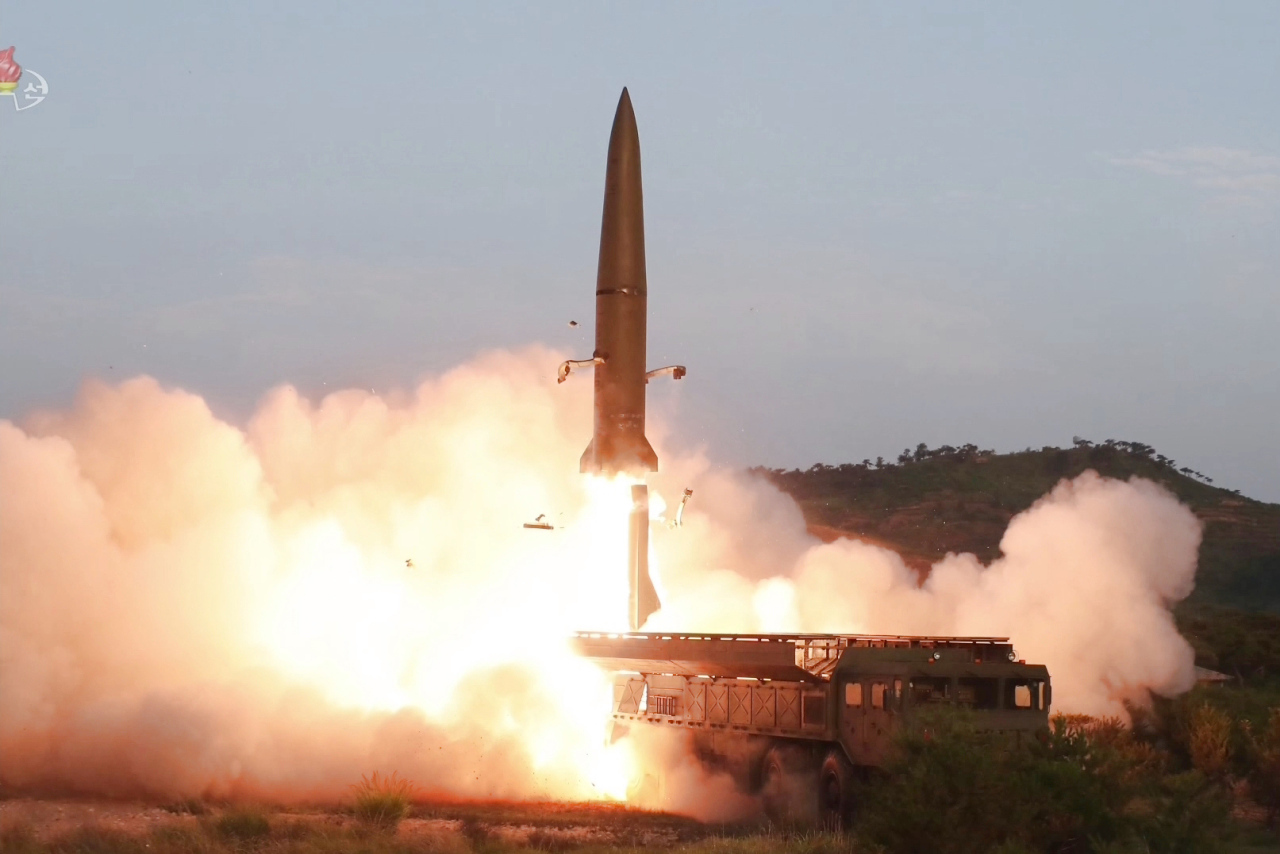N. Korea fires short-range projectiles toward East Sea: JCS
By YonhapPublished : Sept. 10, 2019 - 07:51
North Korea fired two short-range projectiles from a western region toward the East Sea on Tuesday, South Korea's military said, just hours after the communist nation offered to resume nuclear talks with the United States.
The projectiles were fired at 6:53 a.m. and 7:12 a.m. from areas in the city of Kaechon, South Pyongan Province, about 80 kilometers north of the capital, Pyongyang, in a northeastern direction, the Joint Chiefs of Staff (JCS) said.
Both flew around 330 km across the peninsula, reaching a maximum altitude of around 50 to 60 km, the JCS said, while declining to confirm if the two projectiles landed in the East Sea or how fast they flew. The JCS added that South Korean and US intelligence authorities are analyzing their exact type.

"Our military is monitoring the situation in the case of additional launches and maintaining a readiness posture," the JCS said, calling on the North "to instantly stop such acts that heighten tensions."
In response to the latest launches, South Korea held an emergency National Security Council (NSC) meeting, presided over by Chung Eui-yong, chief of the presidential national security office, and reviewed the overall security conditions on the Korean Peninsula, according to Cheong Wa Dae.
In Washington, a senior US government official said it is aware of the latest missile launches and is closely monitoring the situation in cooperation with its allies.
The firings came just hours after the North's First Vice Foreign Minister Choe Son-hui expressed a willingness to resume denuclearization talks with the US in late September and demanded that Washington come up with a new proposal acceptable to Pyongyang.
The launches could be designed to strengthen Pyongyang's negotiating hand ahead of the resumption of the nuclear talks that have been stalled since February's no-deal breakdown of a summit between US President Donald Trump and North Korean leader Kim Jong-un.
Tuesday's firings were the 10th such launches so far this year, during which the North tested new types of missiles or multiple rocket launchers in protest of joint military exercises between the US and the South, among others.
The North last conducted such launches on Aug. 24 from the eastern town of Sondok in South Hamgyong Province into the East Sea, and said it tested a "new super-large" multiple rocket launch system.
"What the North test-fired today could be the same one launched on Aug. 24, taking into consideration its flight range and other features, but we are open to all possibilities, including that they might be another new type," a military officer said.
The projectiles fired on Aug. 24 flew around 380 km at a maximum altitude of 97 km and a top speed of around Mach 6.5, according to the JCS.
"Given that the projectiles were fired from a western region, North Korea appears to have test-fired weapons it already tested previously," Kim Dong-yup, a professor at Kyungnam University's Far East Institute, said.
North Korea generally test-fires weapons from its eastern region into the East Sea, and then, after building some level of confidence, takes them to western areas for additional launches, Kim added.
During the previous nine rounds of tests, North Korea was believed to have showed off four new types of weapons: its version of Russia's Iskander ballistic missile; its version of the US' Army Tactical Missile System (ATACMS); "a new large-caliber multiple launch guided rocket system" presumed to be a 400-millimeter one; and the super-large launcher.
As for its version of Iskander, the North tested it at least five times so far this year, including the launches from its northwestern area of Kusong towards the East Sea.
Though Trump has downplayed North Korea's short-range missile tests, concerns have risen over the weapons, as they are capable of reaching most parts of the Korean Peninsula.
"In parallel with denuclearization talks, Pyongyang appears to be pushing to modernize its decades-old conventional weapons system," Kim said, adding that it would be an effective way for the country to intensify its menace against South Korea and its allies.
Last month, the North's leader sent a letter to Trump and vowed to stop those military acts when the joint exercise concluded. Seoul and Washington wrapped up their exercise last month, but the North has continued to conduct such launches.
Meanwhile, Japan has not asked South Korea to share intelligence with regard to the latest firings, though it made such requests right after the North's previous test last month.
The issue is especially relevant as South Korea announced last month its decision to terminate the military information-sharing pact with Japan, after Tokyo expanded export restrictions on Seoul, citing security concerns, in apparent retaliation against the South Korean top court's ruling on wartime forced labor.
The pact was set to expire in November, and the South Korean defense ministry has said it will continue to exchange classified information with Japan, if needed, until its expiration. (Yonhap)








![[KH Explains] Hyundai's full hybrid edge to pay off amid slow transition to pure EVs](http://res.heraldm.com/phpwas/restmb_idxmake.php?idx=644&simg=/content/image/2024/04/18/20240418050645_0.jpg&u=20240419100350)







![[From the Scene] Monks, Buddhists hail return of remains of Buddhas](http://res.heraldm.com/phpwas/restmb_idxmake.php?idx=652&simg=/content/image/2024/04/19/20240419050617_0.jpg&u=20240419175937)

![[KH Explains] Hyundai's full hybrid edge to pay off amid slow transition to pure EVs](http://res.heraldm.com/phpwas/restmb_idxmake.php?idx=652&simg=/content/image/2024/04/18/20240418050645_0.jpg&u=20240419100350)

![[Today’s K-pop] Illit drops debut single remix](http://res.heraldm.com/phpwas/restmb_idxmake.php?idx=642&simg=/content/image/2024/04/19/20240419050612_0.jpg&u=)